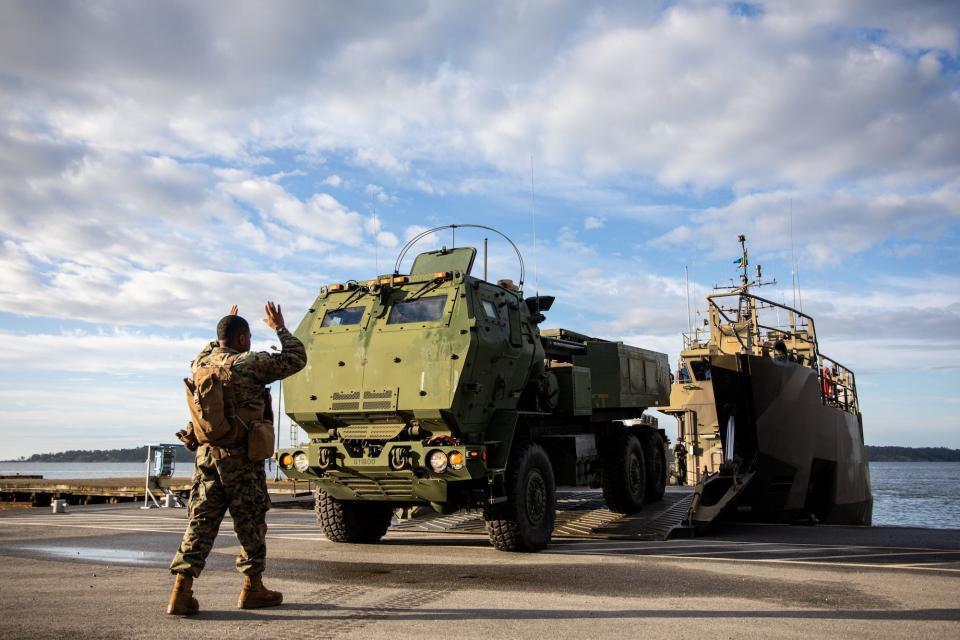A European rival to HIMARS takes shape
Contractors are developing a rocket artillery system for Europe that could rival HIMARS.
The heavier EuroPULS could carry twice as many rockets.
HIMARS may be a victim of its popularity, as Lockheed Martin tries to meet surging demand.
Europe is building a multiple rocket launcher that resembles America's HIMARS, the ground-fired weapon that took on the precision strike missions that Ukraine's battered air force couldn't.
EuroPULS, a truck-mounted multiple rocket launcher, is a collaboration between Franco-German defense firm KNDS and Israel's Elbit Systems. It's based on Elbit's Precise and Universal Launching System, or PULS, which is fielded by the Israel Defense Forces and several European nations.
This raises the question of whether EuroPULS will be a competitor to HIMARS, or High Mobility Artillery Rocket System, a decades-old launcher which made its name in the Ukraine war. Comparing EuroPULS to HIMARS reveals platforms that are similar in concept. EuroPULS is mounted on an eight-wheel truck chassis, while HIMARS uses a six-wheel vehicle. A KNDS fact sheet describes EuroPULS as being 34-feet long, and weighing 38 tons, with a maximum road speed of 55 miles per hour.
That makes it much heavier than HIMARS, which has a combat-loaded weight of 18 tons. But a larger vehicle can carry more rockets. EuroPULS has two pods, which can fire 12 rockets in 60 seconds, depending on the munition. HIMARS has one pod that can fire six GMLRS rockets or one long-range ATACMS missile. The price for a EuroPULS system hasn't been disclosed. But a HIMARS launcher costs almost $5 million apiece, according to 2024 US Army budget figures, while a GMLRS rocket costs more than $100,000 each.
European armies already field multiple launch rocket systems. Many, such as France's LRU and Germany's MARS 2, are based on the U.S. M270, a tracked mobile rocket launcher, and its Guided Multiple Launch Rocket System rockets.

EuroPULS broadens that menu of munitions. EuroPULS can fire a "mix of European legacy and PULS rockets," according to KNDS. Elbit markets a variety of PULS pods. Pod choices include 18 Accular 122-mm rockets with a range of 22 miles, 10 Accular 160-mm rockets with a range of 25 miles, four EXTRA extended-range rockets that can reach out to 93 miles, and two Predator Hawk weapons with a range of 186 miles. Different pods can be mounted on the same vehicle.
What's also notable is that KNDS and Elbit are touting the ability of EuroPULS to fire all sorts of rockets. KNDS says the system is "adaptable to future missiles." Elbit says EuroPULS "will form the basis for a modularly scalable and flexible artillery system that can be integrated to fire from any mobility platform with pinpoint accuracy and safety. The open EuroPULS concept does not exclude any provider of respective missiles from cooperation enabling EuroPULS users to employ those."
This suggests that EuroPULS could fire the GMLRS rockets launched by HIMARS. Except that HIMARS manufacturer Lockheed Martin has said that's not an option. "Our MLRS Family of Munitions cannot be integrated into the PULS system," a Lockheed Martin executive told Defense News. "If Germany was to opt for PULS they could not gain access to our missiles."
Whether EuroPULS could rival HIMARS is complicated. HIMARS does enjoy the immense advantage of its reputation in the Ukraine war, where it proved crucial in helping halt Russia's invasion in 2022. HIMARS rockets destroyed Russian ammunition depots and headquarters, disrupting logistics and command and control, and spurring Russian forces to move vital facilities deeper behind their lines. HIMARS and other GPS-guided weapons such as HIMARS have recently lost some of their luster, as extensive Russian jamming of GPS signals has degraded the accuracy of guidance systems. But for now, multiple rocket launchers are prized items.
On the other hand, KNDS can use economic incentives as a carrot, or at least for European customers; Lockheed Martin produces its guided HIMARS rockets at plants in the US. The KNDS fact sheet stated that "European production base of launcher and ammunition planned."
HIMARS is used, or has been ordered, by more than a dozen nations. But Elbit's PULS has already had some success in Europe, with the Netherlands and Denmark purchasing it, and Germany planning to buy five to replace MARS 2 launchers sent to Ukraine, and possibly as many as 89.
To some extent, HIMARS may be a victim of its popularity, with questions about whether Lockheed Martin can meet surging demand for the launchers and rockets, though the company plans to boost manufacturing capacity. Ukraine for example has ordered new HIMARS launchers and the US Defense Department is replacing the launchers and missiles from its arsenal that it provided to Ukraine.
"Demand for such military capabilities risks outstripping supply, given limitations on how quickly industrial production capacity can be ramped up and given the need to also backfill or provide systems for Ukraine," James Black, assistant director for defense at the RAND Europe think tank, told Business Insider. "There are also industrial policy and security of supply questions at play, with many nations hoping to assure access to production lines and munitions in times of crisis or war, and with many countries hoping to secure lucrative domestic or export contracts. Collectively, such trends are prompting some militaries to consider possible alternatives to the US HIMARS system, though certainly that remains a major player in this competition for contracts."
Michael Peck is a defense writer whose work has appeared in Forbes, Defense News, Foreign Policy magazine, and other publications. He holds an MA in political science from Rutgers Univ. Follow him on Twitter and LinkedIn.
Read the original article on Business Insider

